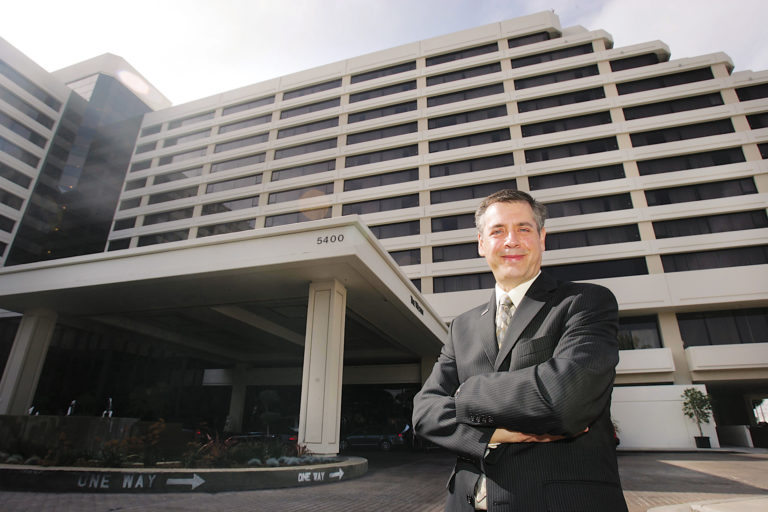
When Los Angeles last increased its hotel bed tax in 1993, local hoteliers were promised that the additional money would boost marketing efforts to promote the city as a tourist and convention destination.
That worked for about 10 years. Then the city raided the bed tax to help fill its own budget hole. That chopped in half the amount of dollars available for promotional campaigns.
Now, with falling occupancy and room rates, local hoteliers are trying a different approach: They are backing a new surcharge on room rates that would go directly to a special marketing district and bypass the city’s general fund entirely. The surcharge would generate about $11 million annually, roughly doubling what’s now spent on tourism marketing.
“We’re not on a level playing field with U.S. cities for conferences and leisure visitors,” said Glen Sampert, general manager of the Westin Hotel at Los Angeles International Airport. “We need a dedicated funding source that is guaranteed to go directly to marketing.”
The surcharge, which would be in addition to the city’s bed tax, would be levied by a special district created by a vote of the city’s major hotels. The results of the vote could come as early as mid-September.
The City Council must also sign off on the surcharge; a council committee is set to consider the issue before Labor Day. The surcharge could be added to room rates before the end of this year.
With the city’s hotel bed tax at 14 percent, the marketing district surcharge would bring total charges to 15.5 percent of room rates. That’s on par with San Francisco, but less than Chicago and New York, which have total tax rates higher than 16.5 percent.
The vote is being spearheaded by L.A. Inc., a non-profit organization contracted by the city to bring in conventions and attract tourists. The money would boost the non-profit’s national and international media campaigns promoting the city and venues such as downtown’s L.A. Live.
In recent years, 40 other California cities have set up similar districts, which apply surcharges on hotel room rates to create a dedicated funding source for marketing. These districts have spread as cities have raided bed taxes – the traditional funding source for marketing.
Los Angeles Councilwoman Janice Hahn, who leads the council’s tourism committee, said the city needs more marketing as a tourist destination and the surcharge will help.
“When I watch television, I see all these ads for other cities,” Hahn said. “We must do a better job in getting the word out about Los Angeles. Tourism is our No. 1 industry.”
But local hotel owners and operators are still concerned that the city may decide to raid the remaining $11 million in hotel bed tax dollars now earmarked for marketing to help close a chronic $500 million budget deficit.
For years, the Los Angeles Convention and Visitors Bureau – now known as L.A. Inc. – received $2, or 2 percent, for every $100 of room rate. However, about six years ago, the city slashed that to $1.
“We’re hopeful that the city leaders see the value of tourism and will continue to provide the 1 percent,” said Mark Liberman, chief executive of L.A. Inc.
Both Hahn and Councilman Paul Koretz said they don’t want the city to divert any more bed tax dollars away from marketing. They cited city figures showing that every 4 percent rise in visitors yields $12 million more for the city’s general fund from the bed tax.
“The multiplier effect of these marketing dollars is so great that it would be penny wise and pound foolish to cut the public contribution,” Koretz said.
Koretz was a City Hall worker in West Hollywood when that city created the state’s first such district, just after incorporating in 1984.
Since then, tourism marketing districts have spread to most of the state’s major markets, including San Francisco and San Diego, which established its district three years ago. Generally, the surcharges range between 1 percent and 3 percent of room rates, on top of bed tax rates that range between 10 percent and 15 percent. In San Diego, a 2 percent surcharge on hotels with at least 70 rooms generates about $27 million a year.
In Los Angeles County, besides West Hollywood, the cities of Claremont, Long Beach, Pasadena and Torrance have similar districts.
L.A. effort
In Los Angeles, a steering committee of 20 hotels has spent the past year ironing out details of the proposal. In addition to the Westin LAX, other hotels on the committee include the JW Marriott & Ritz Carlton at L.A. Live, LAX Airport Hilton, Hollywood Roosevelt, Warner Center Marriott, SLS Hotel and Doubletree San Pedro Hotel.
The surcharge would only apply to hotels with at least 50 rooms, or 192 of the city’s 475 hotels, since neighborhood lodgings generally would not benefit from a broad marketing campaign.
A more intensive marketing campaign would prompt at least one meeting planner to take a closer look at the city.
“If a more vigorous marketing campaign means I would find out about new transportation offerings or new entertainment venues that have opened up, it would pique my interest and make me want to research that city more,” said Virna Tavarez, a certified meeting planner with the American College of Trust and Estate Counsel in Washington, D.C.
Tavarez said she would have to consider the cost of the new surcharge, but believes it is so small and so many other cities are adding them that it would not likely affect any decision.
